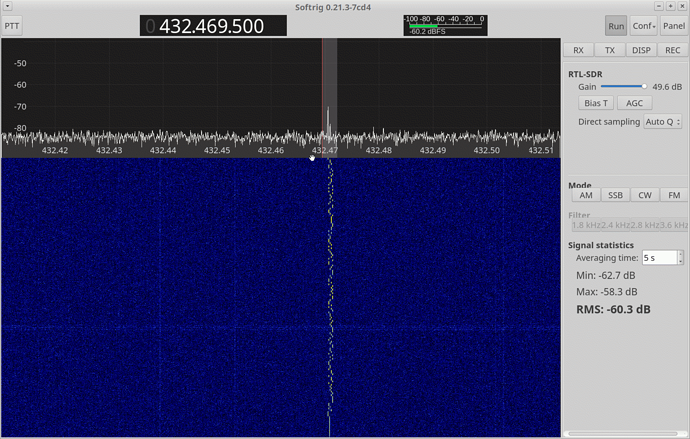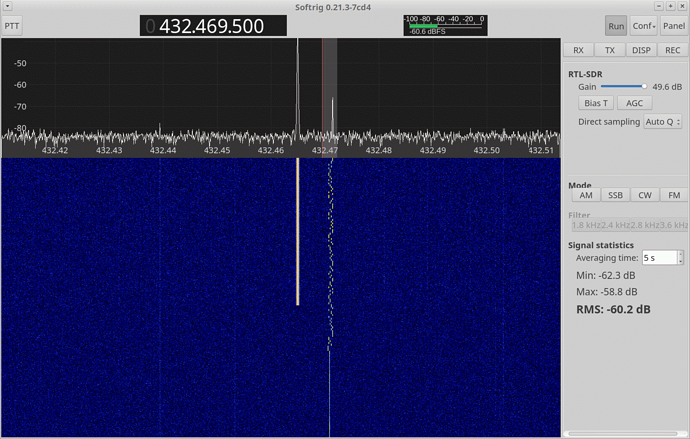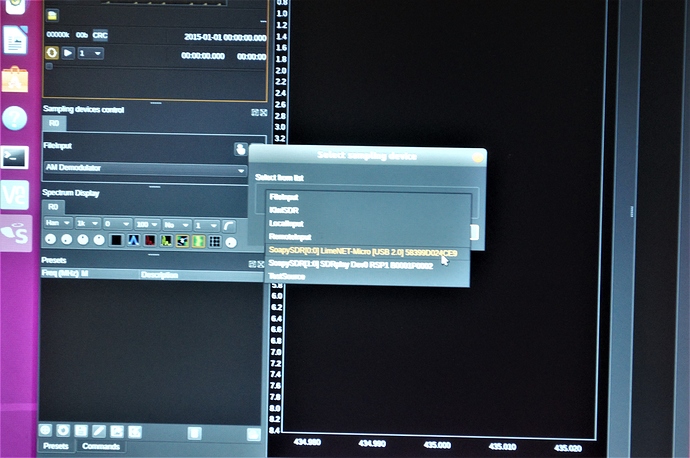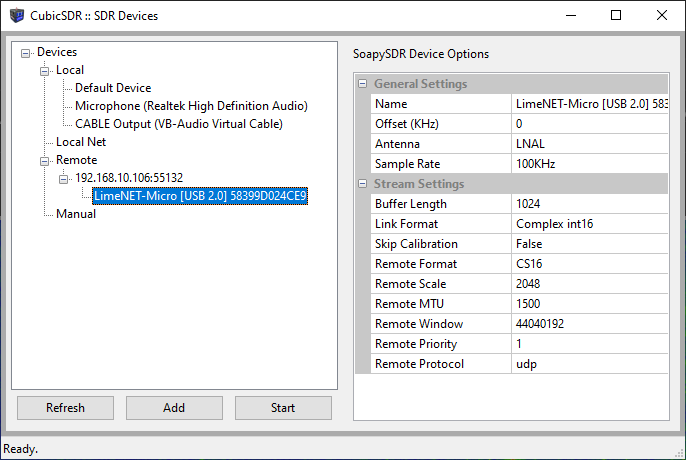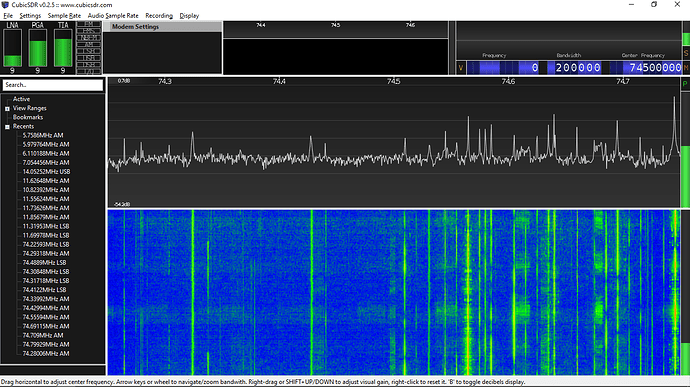I am thinking of upgrading my UHF station (#702) from an RTLSDR to a LimeSDR.
I don’t see a setting for it in the satnogs client, are they supported via some other type?
Station 702 is running on a ACER computer, not a Pi, so I have the CPU power to support the LimeSDR.
hey @thebaldgeek !
LimeSDR support is coming on the next version of gr-satnogs (through usage of gr-soapy) which we are currently testing. As a matter of fact Station 977 is currently running on LimeSDR-Mini with pretty good results (although we still are ironing out the details).
We will be making an announcement when the new version is ready for all people to easily upgrade. In the meantime if you want to help us testing, be sure to drop by #satnogs-dev channel and ask for details on how to test.
Cheers!
Thanks for the reply.
I will get one ordered and be ready to either help out or wait for the release.
Cheers.
Out of curiosity, what do you wish to upgrade? Receiver performance, frequency range, bandwidth, or transmit support?
Receiver performance. I am just looking to tweak the station the best I can for a fixed antenna.
I think the LimeSDR Mini will be the last upgrade I can do to the station.
In a few weeks we will have an independent report with receiver measurements for:
- RTL-SDR V3
- Airspy Mini
- SDRplay RSP duo
- LimeSDR Mini
- BladeRF 2.0 micro
- Ettus USRP B210
- PlutoSDR
We have measured:
- Noise figure (aka. sensitivity)
- Dynamic range (reciprocal mixing, blocking, SFDR – whichever occurs first) at various separations)
- Spectral purity (internal spurs)
for all satcom frequencies (except 1.6 GHz) and all gain settings.
Although our methods are relatively simple and not necessarily 100% “clinically clean lab tests”, they will provide a good basis for making side-by-side comparisons between the different devices.
Any teasers? I’m amazed how well a $20 RTL-SDR V3 works… but I’ve never owned any others. Should be a good read.
Wow! That sounds fantastic! Looking forward to reading about this a great deal! (And secretly hope that the Lime does Ok since I just bought it about an hour ago once I knew support for it was coming soon) .
.
Indeed, one of the big surprises was the performance of the RTL-SDR V3 dongle:
- Noise figure at highest gain around 6 dB (the Airspy Mini is not better)
- Dynamic range around 70 dB
The dynamic range measurements are still to be cross-checked (for the third time) because they are hard to believe. One of the cross-checks we have done was to inject a -75 dBm signal while listening to a weak beacon. As you can see on the screenshots below, the strong signal does not cause any degradation of the SNR of the beacon. At max gain, the measured MDS was -142 dBm, so the dynamic range in this setup is -75 dBm - (-142) dBm = 67 dB, which is unexpected for an 8-bit dongle ![]()
Sorry for going off topic, but where do I find this channel?
or in freenode irc server at #satnogs-dev
Check more at “Get In Touch” wiki page
Good news, like to try on LimeNET Micro when available…
So far managed to run Soapy Remote and CubicSDR is running,
SDRAngel can see devices through network but crash on selection & start of sampling.
Net Micro RX path is more less useless on HF - can not handle even 10,7 MHz IF from PCR 1000
without LNA4HF.
Now using one SDRPlay RSP1 for HF and Net Micro for 110 MHz and up.
Therefore like to try with Satnogs to see can be usefull up there. Limit may be CM3 module
max size of 8 GB
Hi,
I’ve been trying something similar.
LimeNet Micro, with LimeSuite and Soapy.
I seem to be able to get GQRX going remotely, but haven’t been able to control the frequency. I’m not using gr-soapy, but I have setup “SoapySDRServer --bind” on the Pi connected to the LimeNet Micro.
- I still need to do some testing.
I don’t have much experience with the LimeNet Micro, but I suspect I need to configure it to be able to be controlled as a RX device, and maybe in the future a TX device.
I wonder if I also need to run another service on the LimeNet to allow control. Ultimately, I’m trying to get an IQ stream from the LimeNet and control it’s frequency/BW remotely (store IQ locally and do some preprocessing). I see this as my first step to get it going with SatNogs I.e. feed the IQ into the existing python decoders and push TLE observations to it.
Any tips on configuring the LimeNet Micro would be great.
It looks like it can be programmed with a .ini file.
I’m also considering if I can get the FPGA working as a dynamic filter - specific Bandpass for the target frequency and BW.
If I can’t get the LimeNet Micro working, I might need to move to a LimeSDR USB (the USB v3 version).
Thanks
Derek
Here have two LimeSDR USB 1.3 and one LimeNET micro
Was able to setup Soapy remote by use of SDRPlay RPI SD image,
erased some unnecessary SW and installed from source LimeSuite and Lime Soapy
also added some SW for ICOM PCR1000 remote control.
Now have PCR1000 like front end, 10,7 MHz IF out, than moRFeus up conversion
85 MHz - 10,7 MHz => 74.3 “zero” on freq set on PCR1000
Able to use now from 200 kHz to 1.3 GHz on RX all remote.
Running client on W10 and Ubuntu 18.04
Here one remote session on my LimeNET micro:
Maybe I have something wrong with my LimeNet Micro config, but it doesn’t seem to want to change frequency on GQRX or CubicSDR.
- Would you be willing to share an ini file of your config?
What is the connection string you are using?
Mine is the following on GQRX:
- soapy=0,driver=remote,remote=<ip_address_or_hostname>,remote:driver=<remote_driver_name>
Where remote:driver=lime
I’m not currently using the modRFeus as an external clock, although I have one.
I’m assuming it is necessary or are you using it for stability.
As I wasn’t progressing with the above I began looking at rx_sdr, as as equivalent to rtl_tcp.
It looks like rx_sdr works, but outputs to std out, so needs to be piped to something like netcat to allow GQRX to connect to it over a network.
Maybe something like (not tested)
./rx_sdr -d driver=lime -a 50 - | nc -l -u -p 1234 localhost
This doesn’t provide control, which is what I was after.
Thanks so much for spending the time to respond and provide the images.
I suspect I’m missing something on the setup of the LimeNet Micro (all loopback tests work).
Thanks again
Derek
Hello Derek
Sorry here not using GQRX at all.
Please try this first - from client PC, use IP of your local LimeNET micro:
Before that start remote with:
pi@raspberrypi:~ $ SoapySDRServer --bind
C:\Users\S>SoapySDRUtil --find=“remote=192.168.10.106, driver=remote”
######################################################
Soapy SDR – the SDR abstraction library
######################################################
Found device 0
addr = 24607:1027
driver = remote
label = LimeNET-Micro [USB 2.0] 58399D024CE9
media = USB 2.0
module = FT601
name = LimeNET-Micro
remote = tcp://192.168.10.106:55132
remote:driver = lime
serial = 0058399D024CE9
C:\Users\S>
You can also try to run CubicSDR localy on CM3 of LimeNET?
I am using moRFeus for upconversion of 10.7 IF signal because LimeNET is not
sensitive enough to receive at 10 MHz without RF modifications.
Regards
Djani
In case someone may be interested I packed my hardware in case.
Nickname => LimeToGo
